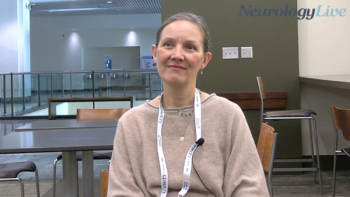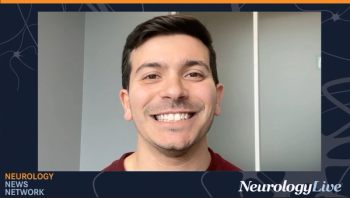
Inside the Phase 3 MASCOT Trial: Lundbeck’s Push for the First Disease-Modifying MSA Therapy
Johan Luthman, executive vice president and head of R&D at Lundbeck, discussed the rationale behind amlenetug, its mechanism of action, and the company’s ongoing efforts in multiple system atrophy through the phase 3 MASCOT trial.
Multiple system atrophy (MSA) remains one of the most challenging neurodegenerative disorders, marked by rapid progression and a complete absence of disease-modifying treatments. The condition, driven by toxic accumulations of misfolded α-synuclein in oligodendroglial cells, continues to elude therapeutic success where Parkinson disease and related synucleinopathies have made modest strides. Amlenetug, an investigational monoclonal antibody from Lundbeck, is being developed to address this critical gap by targeting α-synuclein aggregation and propagation at its source.
At the 2025
Following the meeting, NeurologyLive® sat down with Johan Luthman, PhD, executive vice president and head of R&D at Lundbeck, to discuss the science behind amlenetug as a disease-modifying approach in MSA. In addition, he detailed the design and scope of the MASCOT trial, as well as the learnings derived from the phase 2 AMULET trial, that guided its development. Furthermore, he discussed the importance of patient input in trial design, the logistical hurdles in connecting research for such a rare and fast-progressing disorder, and how Lundbeck aims to make studies more accessible for patients living with MSA.
NeurologyLive: Can you provide some background on the mechanism of amlenetug and the rationale for its use in treating MSA?
Johan Luthman, PhD: The story really begins with protein aggregation—specifically the aggregation of α-synuclein, a small but problematic protein that begins to clump and disrupt normal brain function. MSA is one of the classic proteinopathies, similar in concept to amyloidosis in Alzheimer disease, but in this case, it’s α-synuclein that misfolds and accumulates.
In MSA, these aggregates appear mainly in oligodendroglia, though they also spread to neurons. The same α-synuclein aggregates are seen in Parkinson disease, which I sometimes call the “less aggressive brother” of MSA, since MSA tends to progress much faster. Parkinson disease often presents with mixed pathology—tau tangles, amyloid plaques, and other features—but MSA appears to be almost exclusively an α-synuclein–driven process.
Amlenetug is designed to stop the spread of these α-synuclein aggregates throughout the brain. The working theory, similar to other proteinopathies, is that once misfolded proteins form “seeds,” they propagate from cell to cell. Although MSA has no known genetic trigger, something initiates this aggregation cascade. Amlenetug works by binding to these seeds with an antibody that has an active Fc region, allowing the immune system to help clear them. Essentially, it’s like vacuuming out the toxic α-synuclein buildup—supporting the brain’s immune system to prevent further spread and neuronal damage.
Could you provide an overview of the ongoing phase 3 MASCOT trial and some of the key design elements?
The phase 3 MASCOT trial is our pivotal registration study—its goal is to support potential approval if results are positive. It’s built on the foundation of our earlier, smaller phase 2 AMULET study, which helped us refine the design.
This is one of the largest MSA studies ever conducted, with about 360 patients being followed for 72 weeks, plus an open-label extension. Participants are randomized to a high dose, low dose, or placebo group. What makes this trial particularly innovative is our use of Bayesian progression modeling—a statistical approach that leverages prior data to continuously refine predictions about disease progression. Instead of collecting all the data and analyzing it only at the end, this method incorporates each new data point throughout the study to build a more dynamic model of disease evolution.
We’re also enrolling both main subtypes of MSA: the cerebellar form (MSA-C), which affects balance and coordination, and the parkinsonian form (MSA-P), which presents with parkinsonian features. We aim to include patients as early in the disease as possible, though this can be challenging since diagnosis often occurs late. MSA progresses very rapidly—within seven to nine years, about half of patients have passed away—so early detection and intervention are key.
Our primary clinical outcome is the Unified Multiple System Atrophy Rating Scale (UMSARS), which measures disease severity and progression across multiple domains, including motor ability, speech, autonomic symptoms, and functional independence. The disease milestones captured by UMSARS—loss of mobility, speech, and eventually respiratory function—are all deeply relevant to patients and caregivers.
What insights were gained through the phase 2 AMULET trial?
When we began with AMULET, there was almost no precedent for running a trial in MSA. Natural history data were extremely limited, so we had to do a lot of groundwork to understand the disease trajectory. AMULET was a small, proof-of-concept study with just over 60 patients randomized to two doses of amlenetug or placebo.
The main goal was to explore feasibility and determine if the antibody was engaging its target effectively. We used the same Bayesian modeling approach that we now use in MASCOT because it allowed us to analyze the totality of the data more efficiently. Our statistical bar was set quite high—we targeted a 97.5% likelihood of efficacy. While we didn’t fully reach that threshold, we achieved about 87.5%, which was still remarkably strong given the sample size.
Those results, along with findings from a separate observational natural history study we conducted—called TALISMAN—gave us confidence in both our model and disease assumptions. The TALISMAN data validated what we observed in AMULET and allowed us to refine our projections for MASCOT. Together, these efforts created one of the most comprehensive data sets available in MSA to date, which is critical in such an understudied condition.
Outside of drug development, what unmet needs do you hear most from patients living with MSA?
Luthman: That’s a great question—and one we take very seriously at Lundbeck. Nearly every company says it’s “patient-centric,” but we’ve built this into our process in a structured way. We’ve had a formal patient engagement group for nearly seven years, and we actively consult with patients and caregivers when designing trials.
For MSA specifically, the biggest challenge we hear about is access and logistics. Many patients ask if they’re “too advanced” to participate, or whether they can join a study remotely. Unfortunately, mobility loss often limits their ability to travel to trial sites, which can be far from home. Simple things like transportation and caregiver support become major barriers.
That’s why we focus on early-stage patients but also invest in ways to make participation easier—covering travel support, simplifying visit schedules, and adding patient feedback mechanisms like “exit interviews.” These efforts help us understand what truly matters to patients, from symptom management to maintaining dignity and independence. Ultimately, every insight helps us design better trials—and better therapies—that align with the lived experience of those facing this devastating disease.
Transcript edited for clarity.
Newsletter
Keep your finger on the pulse of neurology—subscribe to NeurologyLive for expert interviews, new data, and breakthrough treatment updates.


































